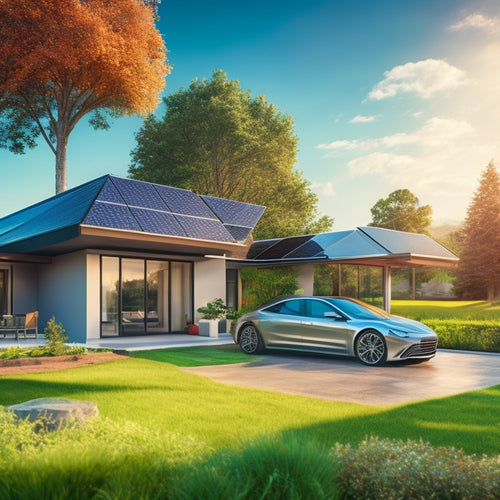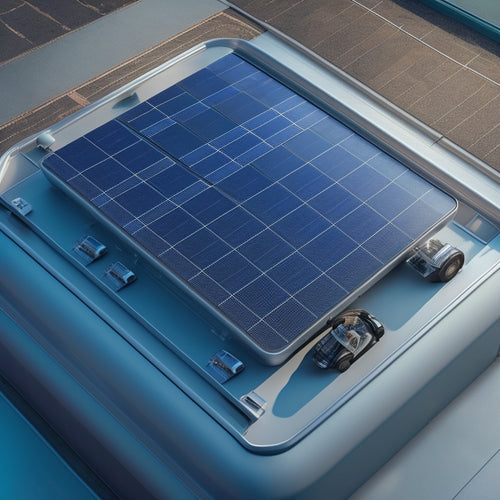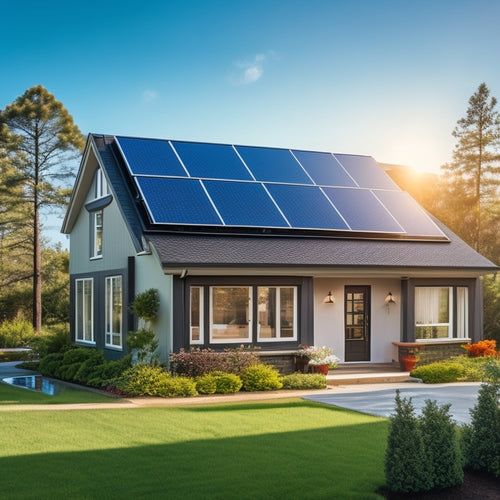
7 Ways to Power Your Warehouse With Renewable Energy
Share
You can substantially reduce your warehouse's carbon footprint and energy costs by integrating renewable energy sources into your operations. Consider harnessing solar power, wind turbines, or hydrokinetic energy to generate electricity. Geothermal systems can efficiently regulate temperatures, while biogas fuels can provide a unique energy source. Energy storage solutions, like battery backup systems, provide a stable energy supply. Green roofs offer an additional energy-efficient solution. By exploring these seven ways to power your warehouse with renewable energy, you'll be well on your way to a more sustainable and cost-effective operation. And, as you explore each option, you'll discover even more ways to optimize your warehouse's energy use.
Key Takeaways
• Install solar panels to reduce energy costs and contribute to a cleaner environment, with a fixed energy rate for 25 years or more.
• Implement wind turbines to increase energy independence and reduce reliance on fossil fuels, with regular maintenance for optimal energy production.
• Utilize hydrokinetic energy, harnessing ocean tides, currents, or waves, for a stable and reliable source of energy, suitable for coastal warehouses.
• Leverage biogas fuels, produced through anaerobic digestion of organic waste, to generate electricity, heat, or fuel for warehouse vehicles.
• Consider geothermal systems to efficiently regulate warehouse temperatures, minimizing reliance on traditional HVAC systems and utilizing the natural temperature of the earth.
Harnessing Solar Power for Warehouses
As you consider powering your warehouse with renewable energy, installing solar panels can be a highly effective way to harness the sun's energy and reduce your reliance on fossil fuels.
With the cost of solar panels decreasing over the years, it's becoming a more viable option for warehouses of all sizes.
By installing solar panels, you can substantially reduce your energy costs and contribute to a cleaner environment.
You'll be surprised at the energy savings you can achieve with solar power.
Depending on the size of your warehouse and the amount of sunlight it receives, you can generate a substantial portion of your energy needs through solar power.
This not only reduces your energy bills but also increases your energy independence.
With solar panels, you can lock in a fixed energy rate for the next 25 years or more, protecting you from rising energy costs.
Wind Turbines for Energy Independence
How much of your warehouse's energy needs could be met by harnessing the power of wind? With wind turbines, you can substantially reduce your reliance on traditional energy sources and increase your energy independence.
A well-maintained wind turbine can provide a reliable source of energy, reducing your carbon footprint and energy costs.
Regular turbine maintenance is vital to guarantee maximum energy production and minimize downtime.
Regular inspections and maintenance can help identify potential issues before they become major problems, guaranteeing energy reliability and minimizing the risk of unexpected outages.
With a well-maintained wind turbine, you can enjoy a stable source of energy, reducing your dependence on the grid and increasing your energy independence.
By investing in wind turbines, you're not only reducing your environmental impact but also taking control of your energy needs.
With the right maintenance and care, wind turbines can provide a clean, reliable source of energy for your warehouse, reducing your energy costs and carbon footprint.
Geothermal Systems for Cooling
You can further reduce your warehouse's environmental impact and energy costs by utilizing geothermal systems for cooling, which can efficiently regulate temperatures while minimizing reliance on traditional HVAC systems.
Geothermal systems take advantage of the consistent ground temperature, which remains relatively constant throughout the year, to provide heating and cooling.
This is achieved through the use of heat pumps, which can transfer heat from the ground to your warehouse or vice versa.
In the summer, the heat pumps extract heat from your warehouse and transfer it to the ground, providing a cooling effect.
In the winter, the process is reversed, providing a heating effect.
This system is highly efficient, as it utilizes the natural temperature of the earth to regulate your warehouse's temperature.
Biogas Fuels for Warehouse Operations
As you explore biogas fuels for your warehouse operations, you'll likely focus on the anaerobic digestion process, which breaks down organic matter to produce biogas.
This process can be paired with fuel cell technology to generate electricity, heat, or even fuel for your warehouse's vehicles.
Anaerobic Digestion Process
Anaerobic digestion, a microbiological process, breaks down organic matter in the absence of oxygen to produce biogas, a renewable energy source that can fuel warehouse operations.
As you consider powering your warehouse with renewable energy, anaerobic digestion is a viable option.
This process involves the decomposition of organic waste, such as food waste or agricultural waste, by microbial communities.
These microorganisms, in the absence of oxygen, break down the organic matter to produce biogas, a mixture of methane and carbon dioxide.
You can harness this biogas to power your warehouse operations, reducing your reliance on fossil fuels and lowering your carbon footprint.
The anaerobic digestion process is a closed-loop system, where the organic waste is converted into energy, and the remaining digestate can be used as fertilizer.
Fuel Cell Technology
Fuel cell technology efficiently converts biogas into electricity, providing a reliable and clean power source for warehouse operations.
As you consider integrating fuel cells into your warehouse's energy infrastructure, you'll want to understand how they work. Fuel cells combine biogas with oxygen to produce electricity, heat, and water.
This process is highly efficient, with some systems achieving fuel efficiency of up to 60%. Additionally, fuel cells can operate continuously, making them an attractive option for warehouse operations that require a constant power supply.
Hydrogen production is also a key benefit of fuel cell technology. By leveraging biogas as a feedstock, you can produce hydrogen, which can be used to power forklifts, generators, or even fuel cell electric vehicles.
This closed-loop system minimizes waste and reduces your warehouse's carbon footprint. When selecting a fuel cell system, look for one that offers high fuel efficiency, low maintenance, and scalability to meet your warehouse's growing energy demands.
Hydrokinetic Energy for Powering Warehouses
You can harness hydrokinetic energy to power your warehouse by tapping into the kinetic energy of moving water, such as ocean tides, currents, or waves.
This renewable energy source is particularly suitable for coastal warehouses, where the ocean's energy can be leveraged to reduce your reliance on fossil fuels.
Tidal power, a form of hydrokinetic energy, harnesses the predictable and cyclical movement of ocean tides to generate electricity.
Ocean currents, another form of hydrokinetic energy, can also be tapped into using underwater turbines.
By deploying these technologies, you can substantially reduce your warehouse's carbon footprint and energy costs.
For instance, tidal power can provide a stable and reliable source of energy, especially during peak hours.
In addition, hydrokinetic energy can be used to power warehouses located near rivers or estuaries, where ocean currents are stronger.
Energy Storage for Renewable Power
As you explore energy storage solutions for your warehouse's renewable power system, you'll need to examine two critical components: battery backup systems and grid stability solutions.
These components work together to guarantee a reliable and efficient energy supply, even when the sun isn't shining or the wind isn't blowing.
Battery Backup Systems
Renewable power systems often rely on battery backup systems to provide a stable and consistent energy supply when the sun isn't shining or the wind isn't blowing. As you explore ways to power your warehouse with renewable energy, you'll want to examine the importance of energy storage.
Battery backup systems are vital in ensuring that your operations remain uninterrupted during periods of low energy production.
Load shedding is a key benefit of battery backup systems, allowing you to prioritize energy allocation during periods of high demand, reducing the risk of power outages.
In the event of a power outage, battery backup systems can provide a reliable source of energy, minimizing downtime and losses.
By storing excess energy generated during peak production periods, battery backup systems can reduce energy waste and optimize your energy usage.
Battery backup systems can be scaled up or down to meet your warehouse's unique energy needs, making them a flexible and adaptable solution.
Battery backup systems are essential in ensuring that your operations remain uninterrupted during periods of low energy production.
Grid Stability Solutions
Grid stability solutions, such as energy storage systems, step in to stabilize the grid when renewable power sources fluctuate, maintaining a reliable supply of electricity to your warehouse.
As you integrate renewable energy into your warehouse's power mix, you'll need to address the intermittency of solar and wind power. That's where grid stability solutions come in.
These solutions, including energy storage systems, help balance the grid by storing excess energy generated during peak production periods and releasing it when needed.
To provide a stable and reliable power supply, you'll want to implement power forecasting and energy balancing strategies.
Power forecasting involves predicting your warehouse's energy demand and adjusting your renewable energy output accordingly.
Energy balancing, on the other hand, involves adjusting your energy storage levels to match your warehouse's energy demand in real-time.
Green Roofs for Energy Efficiency
You can reduce your warehouse's energy consumption by up to 25% by installing a green roof, which provides additional insulation and reduces the urban heat island effect.
This innovative solution not only saves energy but also creates an urban oasis in the midst of industrial activity. A green roof is a layer of vegetation planted on top of your warehouse, functioning as a natural barrier against the elements.
Stormwater management: Green roofs absorb rainfall, reducing stormwater runoff and alleviating pressure on drainage systems.
Urban heat island mitigation: Vegetation helps to cool the air through evapotranspiration, reducing the urban heat island effect.
Noise reduction: Green roofs can act as a sound barrier, minimizing noise pollution.
Aesthetic appeal: A lush, green rooftop can become a tranquil oasis for employees, boosting morale and productivity.
Frequently Asked Questions
Can Renewable Energy Systems Be Integrated With Existing Warehouse Infrastructure?
You can integrate renewable energy systems with your existing warehouse infrastructure through an infrastructure upgrade, which may involve an energy retrofit to ensure a seamless transition to sustainable power.
How Do Government Incentives Impact the Cost of Renewable Energy Systems?
You'll find that government incentives substantially reduce the cost of renewable energy systems, offering benefits like carbon credits and tax breaks, which can offset up to 30% of your initial investment, making sustainability more affordable.
What Are the Maintenance Requirements for Renewable Energy Systems?
You'll need to plan for scheduled downtime and regular onsite inspections to guarantee your renewable energy system runs efficiently, identifying potential issues before they become major problems, and extending the system's lifespan.
Can Energy Storage Systems Be Used for Backup Power During Outages?
You can guarantee energy resilience and grid independence by utilizing energy storage systems as backup power during outages, providing a reliable and efficient solution to keep your operations running smoothly.
Are Renewable Energy Systems Compatible With Existing Energy Management Systems?
You'll be pleased to know that renewable energy systems seamlessly integrate with existing energy management systems, allowing for efficient grid connection and real-time energy monitoring, ensuring a smooth shift to sustainable power.
Related Posts
-

What Solar Panels Work Best With EVS Online?
When shopping for solar panels online to power your electric vehicle, look for high-efficiency models that can withst...
-

Top Solar Panels for Car Battery Maintenance
When selecting top solar panels for car battery maintenance, consider high-efficiency models with high wattage output...
-

Solar Power Units Perfect for Homes
You're considering installing a solar power unit in your home, a decision that can notably reduce your reliance on tr...


